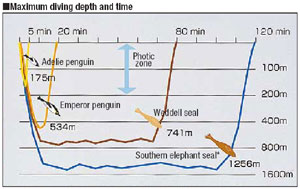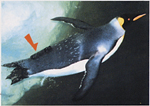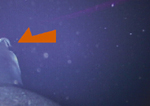Ocean Newsletter
No.89 April 20, 2004
-
New evolution in oceanic research by bio-logging - Mysteries of the ocean solved by creatures -
Yasuhiko Naito National Institute of Polar Research / Selected Papers No.6(p.21)
Oceanic research has progressed with the research and development of tools for making observations in the deep sea as well as for grasping phenomena. Dynamic oceanographic observation has become possible by research vessels and investigation vessels as well as various types of observation equipment. Also, it has become possible to keep the track of environmental changes that may occur during the tracking of movements and migration cycles of creatures living in the sea, by applying the newly developed animal-borne bio-logging technology.
Selected Papers No.6(p.21) -
An image of the "Water Planet" in the new millennium
Takashi Hamada Chairman, The Japan Science Society
The "Water Planet" should not be recognized simply as it was named because more than 70% of the earth's surface is dominated by oceans when observed from artificial satellites. Water exists everywhere including in the solid earth and creatures as well as in the fluid earth. The "Water Planet" is the life of the Earth itself including human beings, so we should refrain from "short-sighted" activities, which depend on conventional methods, for utilization of this planet in the new millennium.
-
High hopes for promotion of tourism in Ogasawara Island by the Techno Super Liner
Masaaki Shibuya Manager, General Affairs Division, Ogasawara Village
The Ogasawara Islands consist of more than 30 islands large and small, where Chichijima and Hahajima Islands are in the center and located 1,000 km south of Tokyo. At present, the time required from Tokyo to Chichijima Island is 25 and a half hours by the "Ogasawaramaru" liner, while the Techno Super Liner, which will go into service in the spring of 2005, will link them in 17 hours. Reduction of the operating hours is expected to promote tourism, because tourists who would visit the Ogasawara Islands before now have had to set aside at least 6 days for the trip.
New evolution in oceanic research by bio-logging - Mysteries of the ocean solved by creatures -
Oceanic research has progressed with the research and development of tools for making observations and understanding phenomena in the deep sea. Dynamic oceanographic observation has become possible by research and survey vessels and various types of observation equipment. In addition, it has become possible to keep abreast of environmental changes that may occur during the tracking of the movements and migration of creatures living in the sea by applying newly developed bio-logging technology.
Marine research: out of ignorance
The ocean is a cradle and treasure house of living creatures. Two thirds of the earth's surface is ocean, which is mostly several thousand meters in depth. The gigantic water mass of the ocean has greatly affected the global environment and human life. People have also been making use of the ocean since ancient times for transportation and fisheries and humankind has long been accumulating knowledge about ocean currents, meteorological conditions and living creatures. Recently, our knowledge has increased through scientific research, but asked if this knowledge extends equally across all fields of marine science, the answer must be no. The ocean is a gigantic threedimensional space where many marine-related phenomena undergo momentary changes and there remains a big issue as to how changes and fluctuations in this space should be understood.
In marine research, how the ocean should be viewed as a world of its own is a significant issue. The interior of the water mass cannot be seen through, but stars in the universe can be clearly seen, like when we say, "It's like stardust." This difference between outer space and the ocean greatly affects our way of thinking. The starlit sky can be seen by everyone, and the universe provides us with many dreams and inspires an adventurous spirit. The deep ocean does not give us any dreams or inspire such a spirit. Living creatures in the ocean are described as devils or monsters. Those dreams and an adventurous spirit will create inquisitive minds for the future. However, the black abyss of the ocean hardly inspires an inquisitive, futuristic mind with dreams or an adventurous spirit. In this way, one may say that marine research did not begin in search of an unknown world, but rather started out of ignorance. Of course, a quest for the unknown was steadily pursued in marine research, with fragmentary documents introduced from time to time about living creatures guiding us into the world of the unknown.
Technology of seeing through the ocean
Just as development research on telescopes and other subsequent tools has been important for space research, the development of tools has been important for marine research as well. In particular, tools for collecting were indispensable during the early stages of marine research. However, new tools were needed in order to look into the deep ocean or to catch dynamic phenomena, and in recent marine research various ultrasonic tools have played a major role. At the same time, people dreamed of diving by themselves in order to see through the ocean directly. As for modern tools, there is scuba diving equipment as well as manned and unmanned submarines and great progress has been made in the world of the ocean through equipment. Of course, there is also innovative observation equipment for various research and investigation vessels. Later, offshore exploration and research entered the era of fullyfledged dynamic observation with the use of various unmanned buoys, followed by the era of monitoring observation for the monitoring of the global environment.
Bio-logging technology
 *The latest record indicates that the maximum diving depth of southern elephant seals is 2,000 meters.
*The latest record indicates that the maximum diving depth of southern elephant seals is 2,000 meters.
However, all of this was insufficient in seeing through the water mass of the ocean. In particular, when creatures travel (unfortunately, most of the creatures in the sea do travel), it is difficult to track them. It is almost impossible to keep track of creatures and environmental changes and things that may occur during the tracking of their movements and the migration of creatures in the sea. Because of this, new tools were necessary, and for this purpose biologging technology was invented. Bio-logging is a method of obtaining data by mounting a small recorder on the body of an animal, monitoring the animal's behaviors and the environment around it, and collecting the device or wiring information. The method was originally developed in order to conduct research on the diving behaviors of seals, penguins and sea turtles, and the device was called a time depth recorder (TDR). For this method, recorders need to be collected, so the method was developed for penguins and seals who invariably return to their habitats. Research with the use of the time depth recorder revealed that seals and penguins dive much deeper than imagined and discovered the strange behaviors of animals that were found to dive deep. For instance, southern elephant seals dived to depths of 2,000 meters for two hours, emperor penguins dived to depths of 530 meters for 20 minutes, Weddell seals dived to depths of 740 meters for 80 minutes, and Adelie penguins dived to depths of 175 meters for five minutes. Even leatherback sea turtles, which are ectothermic reptiles, dived to depths of 1,000 meters or more for one hour. This obviously raised various questions such as, "Why do they need to dive that deep?" and "Why can these animals, which use lungs to breathe in air, dive that deep for long periods of time by only holding their breath?"
 King penguin with a data logger mounted
King penguin with a data logger mounted A camera caught a Weddell seal at a moment when it was feeding at a depth of 315 meters.
A camera caught a Weddell seal at a moment when it was feeding at a depth of 315 meters.
In the 1990s, equipment was further digitized and downsized, and its capacity was increased and multichannels were provided. Miniaturization is the most important technological issue for this research in order to reduce the load of equipment and the impact of the equipment on animals. It became possible to detect minor movements, postures and three-dimensional locations of animals, and to know about animals feeding underwater, as well as the migration and movements of the animals while they feed with the use of accelerated velocity and geomagnetic sensors, meaning that many things were revealed. These animals dived all the way to cold and dark intermediate and deep water in order to feed, past marine surface layers where it was believed that there was abundant food for them because there were various phytoplanktons there. Because of that, their ways of diving are unique. It also revealed that animals do all kinds of things to save their kinetic energy. For instance, one seal sank itself down without making a movement when it dived, and penguins accelerated and surfaced without flapping their wings. There are a great many high-level predatory animals that rely on marine production, however, and strangely enough, 30% to 40% of high-level predatory animals have feeding grounds in deep water like this. Our next questions are, what do they eat and how is their food distributed?
Our next tool is an image logger. Images show exactly what underwater animals and animals moving through the environment see. They expose us to the world of the black abyss of the sea for the first time. Through these tools, the diving habits of a seal that lives in the Antarctic icy seas and its feeding environment were revealed for the first time. This seal dived quietly toward the bottom of the sea in a straight line, swam slowly near the bottom and picked off Pleuragramma antarcticum and other small fish one by one. Seals do not have to hunt big fish in the deep, dark sea, so they dive many times and move their feeding places little by little each time they dive.
From ignorance to the unknown, and a new marine world
Greatly benefitting from digital technology, bio-logging technology is about to enter an age of new development. Animals that move deep vertically, or migrate horizontally in a wide area provide oceanographic platforms. At the same time, animals themselves can act as marine sensors. Animals make a selection for their existence by obtaining information on minor changes in the sea and marine environment. Different from conventional ways of exploring the ocean, it is greatly anticipated that bio-logging will reveal new aspects of the ocean to us in the future. With information provided by animals as a guide, we must further explore the unknown - a journey we began out of ignorance - to discover a new ocean, as well as ways to protect the marine environment where people and animals can coexist.
